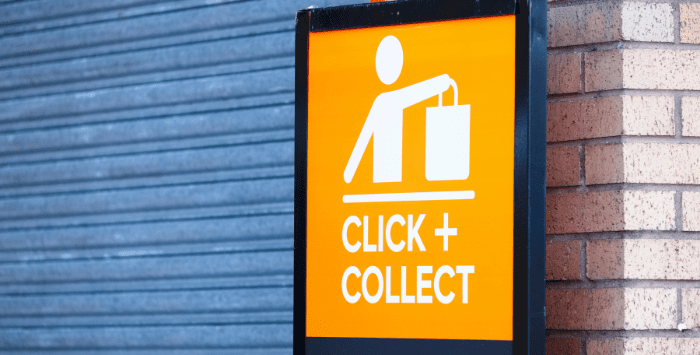
Here are our top tips for providing the ultimate Click and Collect experience.
>Share this post<
by kooomo
July 30, 2021
Click and Collect services have been a saving grace for many retailers throughout lockdowns and restrictions. It has not only provided a means for which to keep bricks and mortar stores open but drives sales with impromptu in-store purchases. Without a doubt, click and collect services are in demand with turnover forecasted to soar to €11.9 billion by 2023. The offering has shifted from a “nice to have” to a “must-have” feature for retailers as 43% of UK shoppers intend to continue using the services as restrictions ease and normality returns - suggesting a permanent shift in shopping habits for some customers. So what’s next for retailers? Well, implementation for those who have not yet dabbled - for the rest? Perfection. Here are our top tips for providing the ultimate Click and Collect experience
How to perfect your Click and Collect experience
1. Check your tech
When trying to implement click and collect into their offering, the most common concern retailers have is choosing the right technology. Some might find themselves on outdated systems or platforms that don’t (easily) lend themselves to new processes such as this. When you’re offering click and collect, the quality of the service must match up - otherwise, consumers won’t bother with it and you could end up with a bad reputation. With click and collect you are adding another layer of functionality to your site that needs to be dynamic and agile enough to exceed customer expectations. One-click integrations are the most convenient way to build up this functionality. Your platform should make it as easy as possible for you to provide a full omnichannel experience to your customers.2. Offer click and collect as a free option
Consumers love to have options and appreciate when brands can adhere to the consumers’ habits instead of the other way around. While at-home delivery is a more flexible option now that people are working from home, the cost of delivery can still deter consumers from completing their orders. In fact, unexpected shipping costs are the number one reason for cart abandonment. Therefore, offering click and collect for free Is a simple way to appease the masses AND draw them into your store. There are some retailers that still charge for Click and Collect, however, which can take the convenience out of the option. Take Boots for example. Boots will offer free click and collect if consumers spend a certain amount. This is a great way to up-sell, but you do run the risk of causing frustration, losing repeat customers and good word of mouth.3. Tracking System
The importance of a tracking system is not confined solely to home deliveries. As we mentioned before, consumers want to be able to plan their visits - gauging times and days that are convenient for them to collect. 97% of customers expect the ability to monitor their orders throughout every step of the shipping process. As experience has become the key differentiator between retail competitors, shoppers have become accustomed to a high level of visibility into their orders. Additionally, having answers for customers is far more satisfying for them than generalisations and continual apologies.4. Collect and utilise the right data
Clarity is key when it comes to the click and collect experience with 83% of consumers expecting regular communication about their purchases. Consumers need to be notified when their order has been received, shipped and out for delivery be that by text, email or push notification. This is considered a huge win when it comes to providing convenience and a great experience. Make sure you capture the correct email and phone data during the checkout process so that emails and messages arrive at the right person at the right time. A good way to minimise these errors is by implementing phone and email validation. Not only that but notifications should also include the order reference number, opening hours, what’s needed to collect the order, and how long the order will be held in-store.5. Clear signage & designated areas
This is really a no brainer given signage, sanitising and distancing have been a major part of the retail overhaul. As restrictions ease, more and more consumers are planning their visits ahead of time. Have signage that clearly shows customers the exact collection point. Positive Click and Collect experiences focus on minimised friction and avoiding unnecessary contact. If you’re tight on space, you can also advise that consumers approach floor staff. Some retailers such as Bershka, use tablets to collect the information from the shopper where they stand and return the item to them on the shop floor. This means they do not have to stand in long queues, can continue to browse and therefore might make more purchases.6. Fully train your staff
Train people well enough so that they can leave, treat them well enough so they don’t want to - Richard Branson. Having fully trained, knowledgeable staff is half the battle when it comes to providing a truly positive click and collect experience. You should have procedures in place for your staff so that they know what to do from the moment a click and collect order arrives at the store to the moment it’s collected (and if necessary, returned). Customers should not be left waiting long for the package to be retrieved. In essence, your sales team should be your biggest click and collect advocates7. Make click and collect the star of your website
Don’t underestimate how many consumers seek out click and collect services when shopping online. This offering should be front and centre of your website when your consumers arrive and re-iterated throughout the customer journey. A lack of clarity could result in cart abandonment. Customers should be able to see that click and collect is an option as early on in the purchasing process as possible.8. Use a store locator
Realistically, click and collect is only the convenient option when it is in fact, convenient. Customers won’t opt for a free service if it costs them an arm and a leg to get there. Adding a store locator to your site is a great way to overcome this and using location services to suggest the nearest point is all the better. At the very least, you should provide the address, postcode, contact number and opening hours on your site. Store locators add something to your website that others can’t: value. Not only is your website the go-to for this kind of info but your customers get the answers they are looking for any time, anywhere. Online shopping then becomes extra convenient for your customers as they can check local store inventory items 24/7.9. Returns
92% of consumers say that they will shop with a brand again if the product return process is easy and 62% of shoppers are more likely to make online purchases if they can return in-store. While managing returns is a slippery slope to navigate, the consumer experiences need to remain front and centre. That means, offering consumers the ability to return items from whence it came. Your consumers don’t view your channels as separate entities - they only see your brand as a whole. Therefore, you should allow click and collect orders to be returned to any of your stores. It might sound complicated in terms of stock management, however, DOM (distributed order management) can help with efficiency.10. Mobile optimised
Click and collect is no exception to the mobile-first approach that eCommerce brands need to take nowadays. UK purchases made through mobile devices account for one-third of online shopping - which means retailers cannot turn a blind eye to mobile optimisation. Smartphone location features should enhance the customer experience by identifying their closest store. Customers need to be able to order through your mobile site for collection in-store at their convenience. Therefore, smartphone and tablet compatibility should be high on your list of priorities, with the click and collect function offering a suitably seamless mobile user experience.So what do you think? Is click and collect no longer a ‘like to have’ but more of a ‘must have’ for brands with a bricks and mortar presence? If you believe the answer is yes, then these tips should help you on the way to providing the best possible omnichannel experiences. If you wish to delve a little deeper, check out “omnichannel features” on our website - or better yet, book in a chat with our team who’ll be happy to answer all your queries.
More to explore
Here’s an overview of the latest improvements that are now available in the Kooomo platform.
In the next few years, we are foreseeing an impressive increase for the global retail industry. While this can be beneficial for the global eCommerce industry, it also means that there will be more competition, as well.

 en
en 

